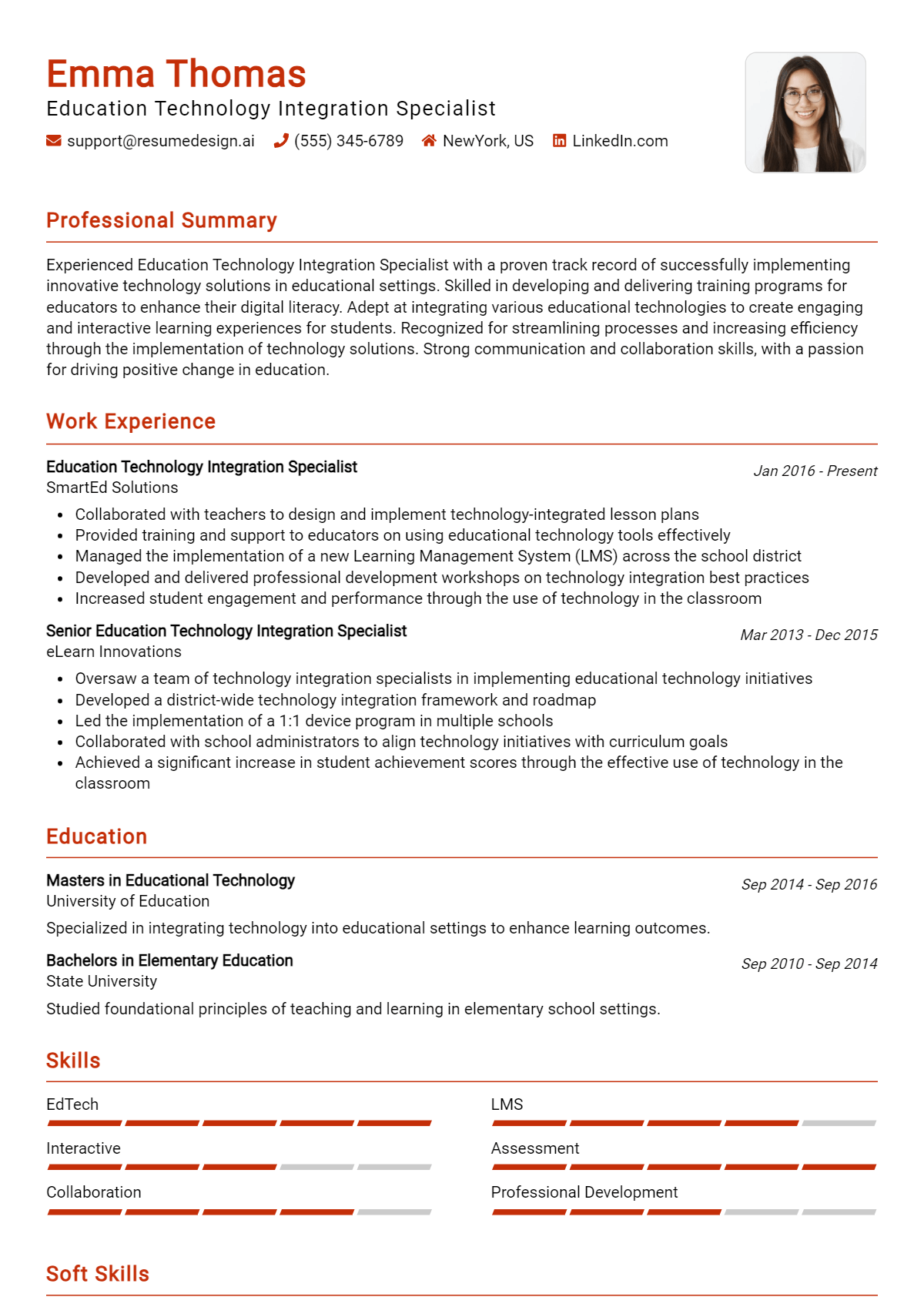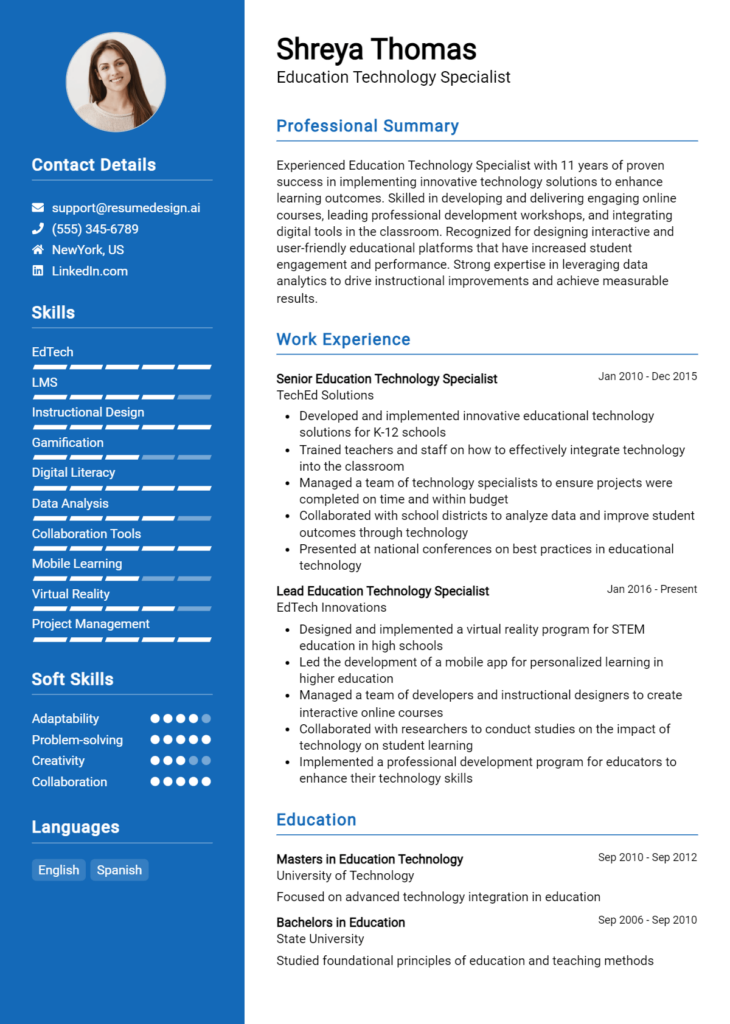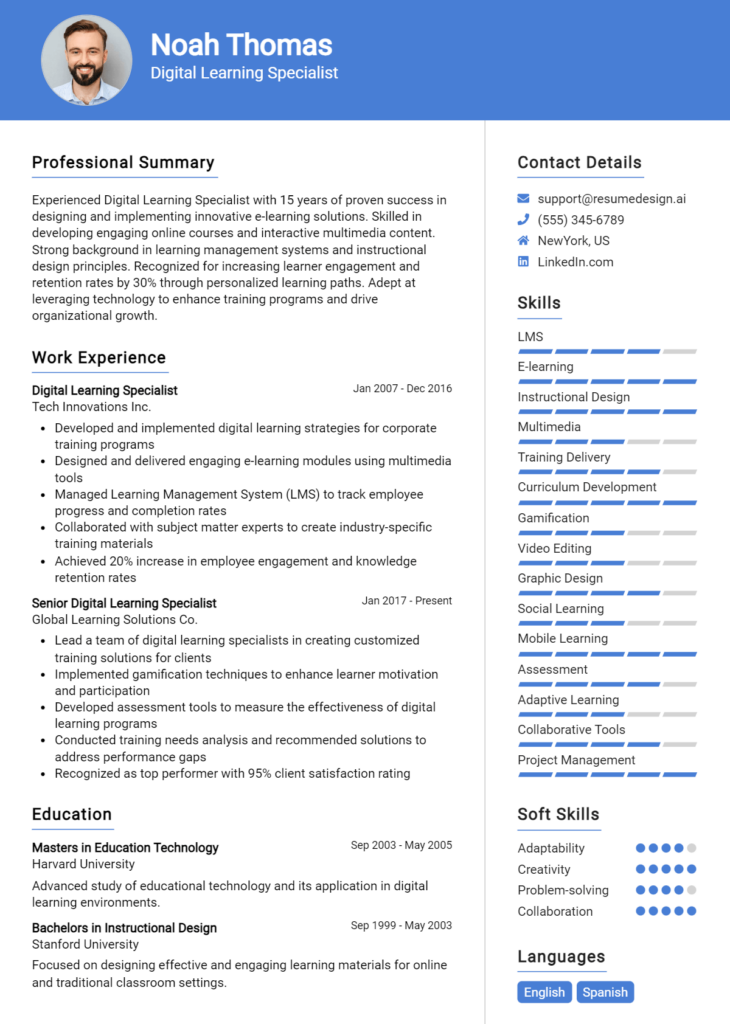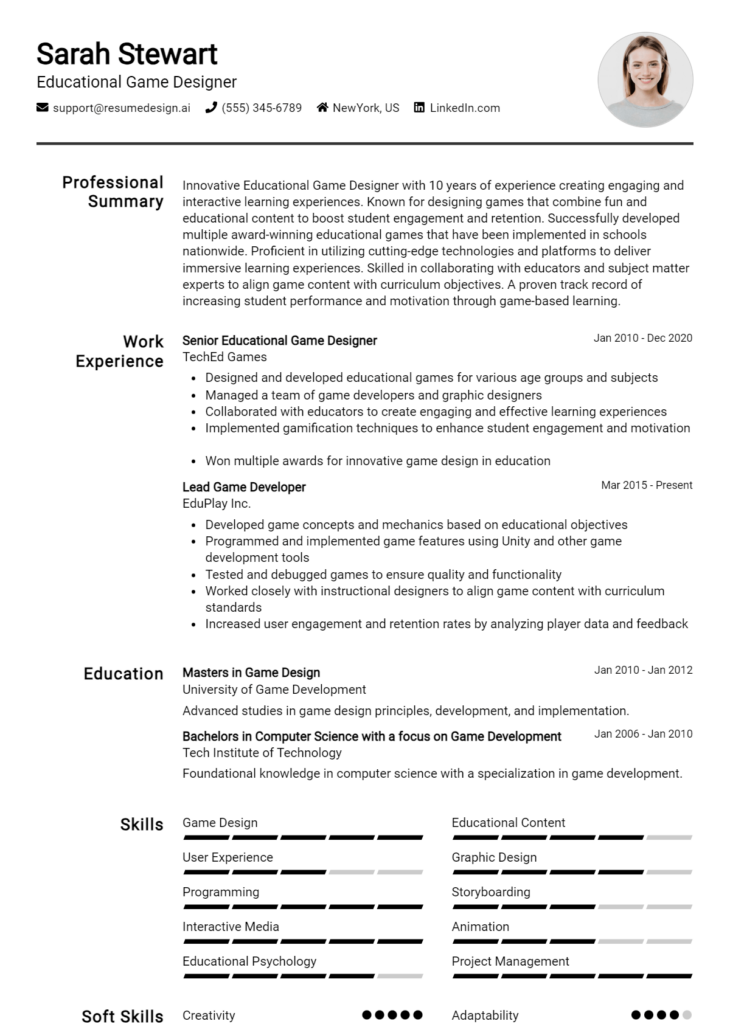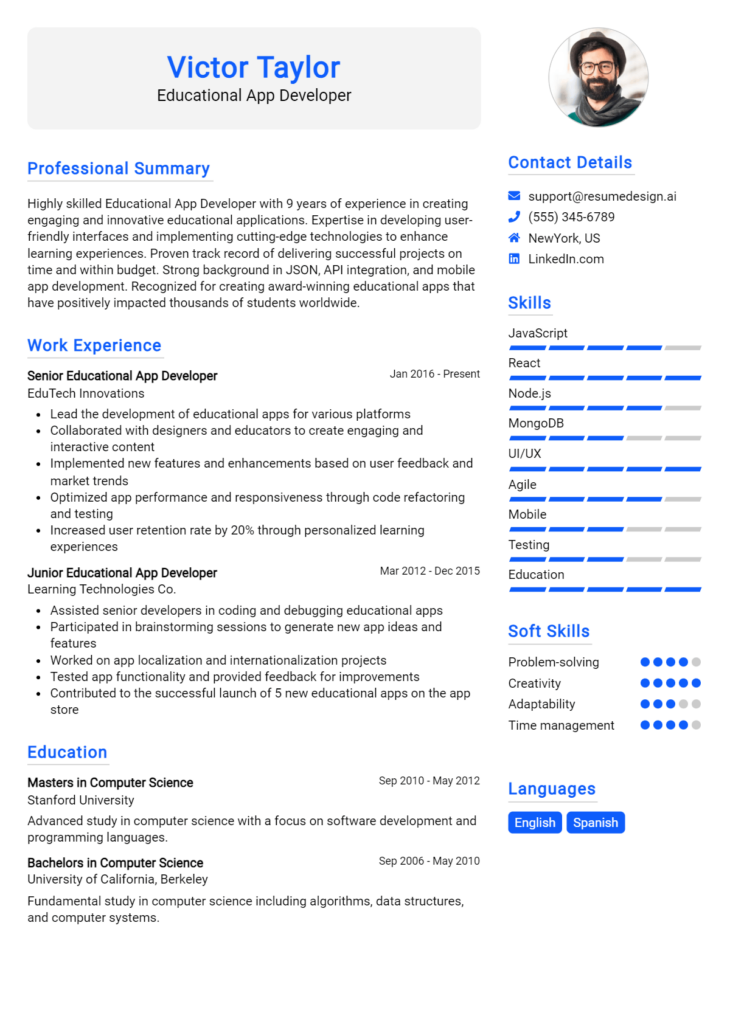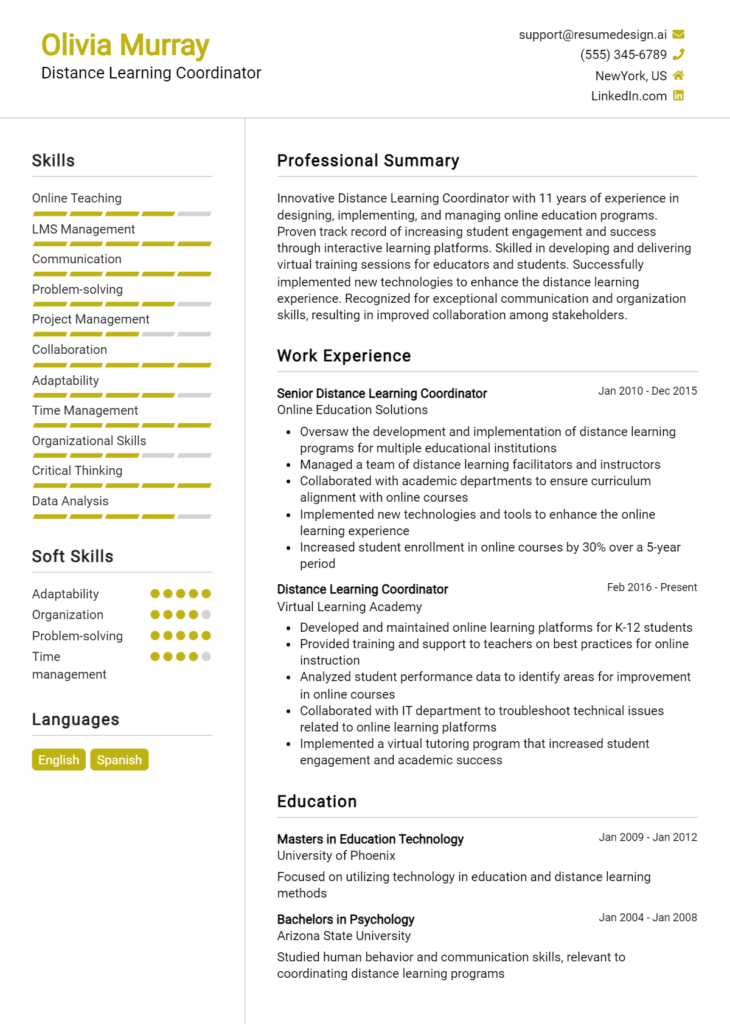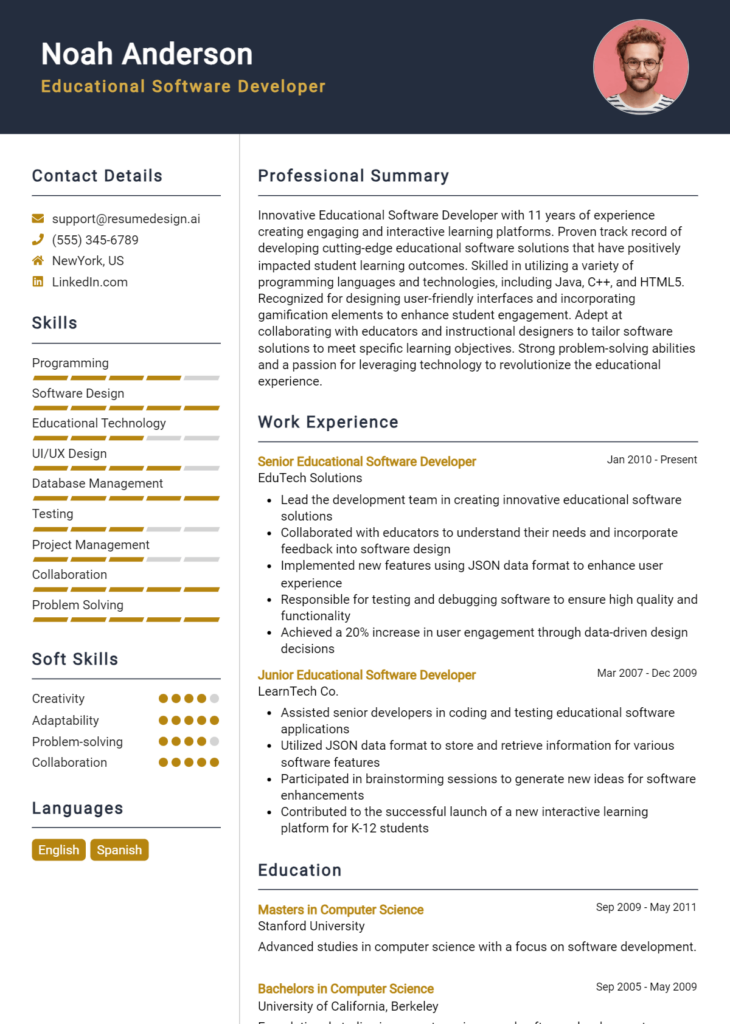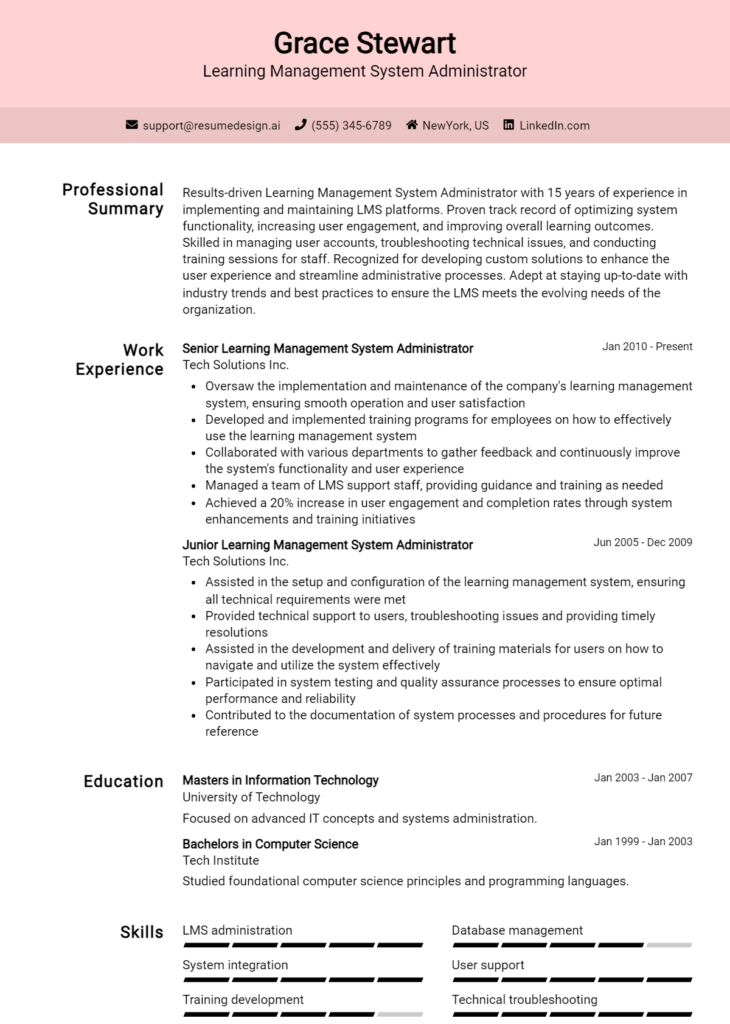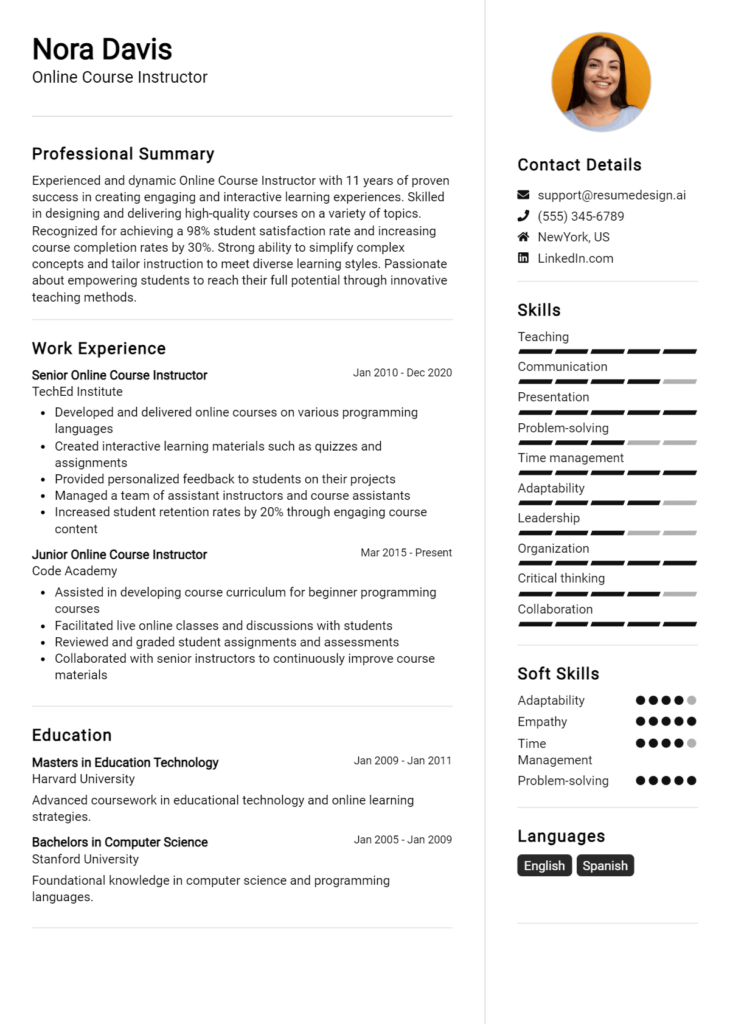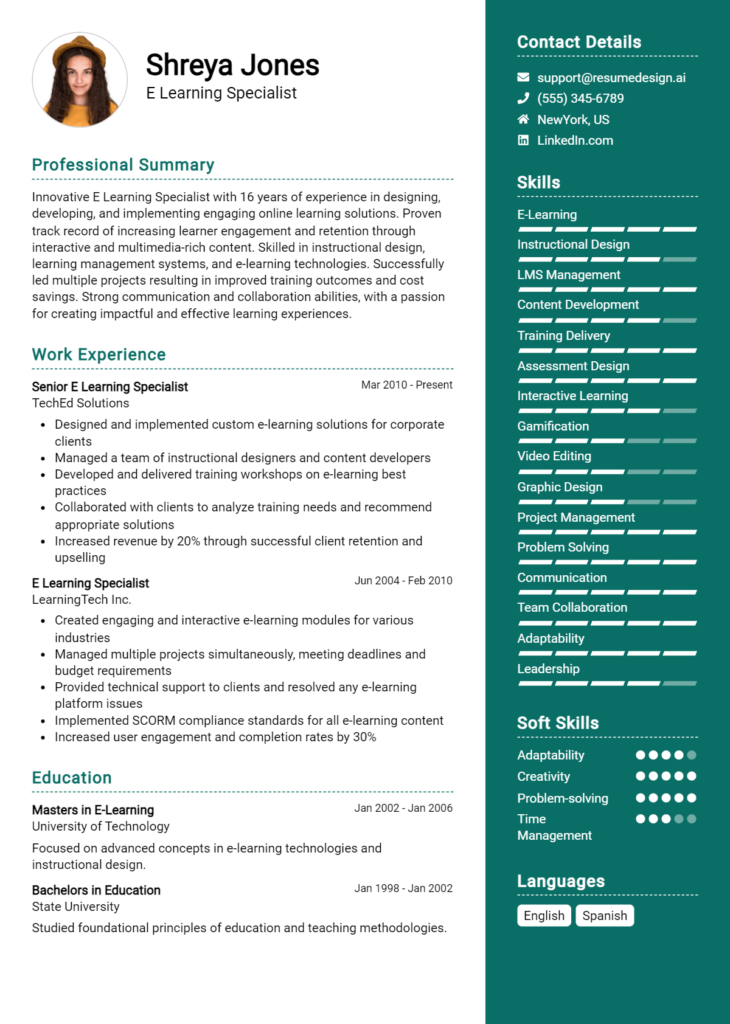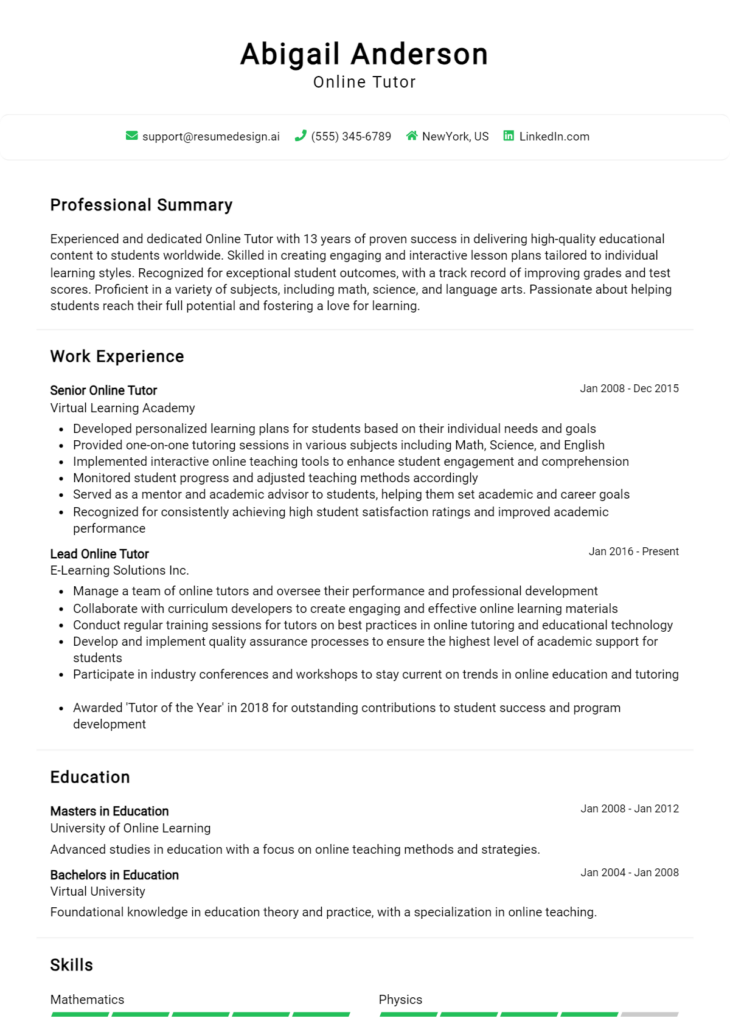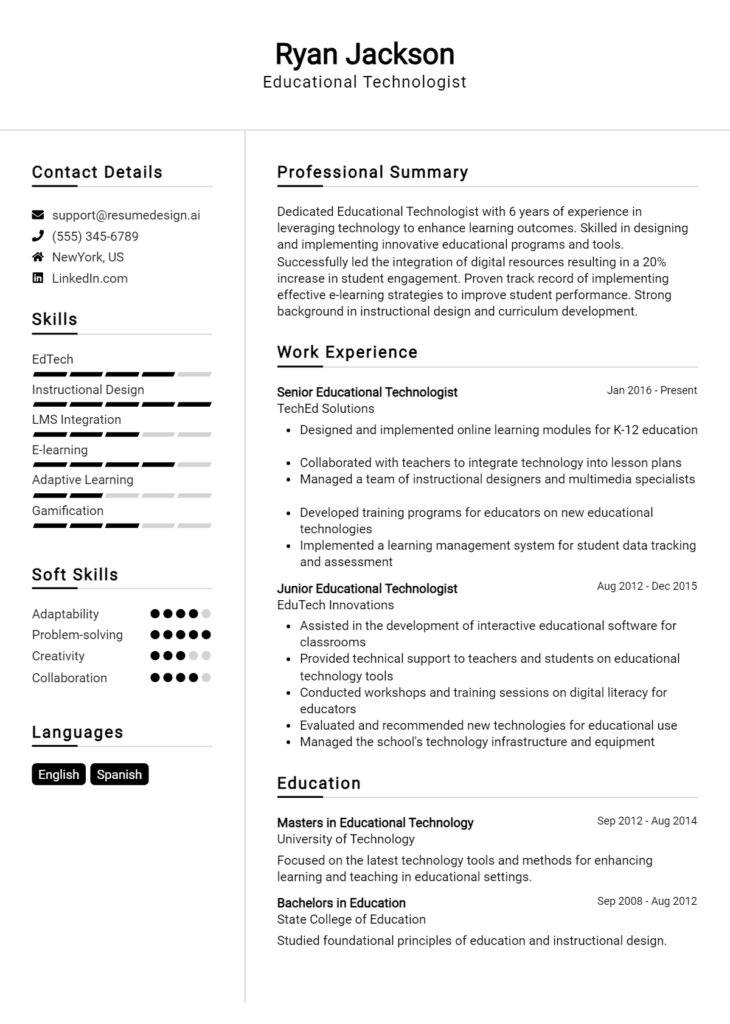Education Technology Integration Specialist Core Responsibilities
An Education Technology Integration Specialist plays a crucial role in enhancing learning experiences by bridging various departments, such as IT, curriculum development, and teacher training. Key responsibilities include implementing educational technologies, providing training, and offering ongoing support to faculty and students. Essential skills encompass technical proficiency, operational insight, and strong problem-solving abilities, all of which contribute to the organization's educational goals. A well-structured resume effectively highlights these qualifications, showcasing the candidate's impact on technology integration and educational success.
Common Responsibilities Listed on Education Technology Integration Specialist Resume
- Assessing and selecting appropriate educational technologies for classroom integration.
- Providing training and professional development for educators on tech tools.
- Collaborating with stakeholders to design and implement technology strategies.
- Monitoring and evaluating technology usage and effectiveness in education.
- Offering technical support to faculty and students in technology-related issues.
- Creating instructional materials and resources for technology integration.
- Staying updated on emerging educational technologies and best practices.
- Facilitating communication between departments regarding technology initiatives.
- Developing and managing technology integration projects and timelines.
- Conducting workshops and seminars to promote technology adoption.
- Documenting and reporting on technology integration outcomes and successes.
- Advocating for the needs and interests of both students and educators in technology planning.
High-Level Resume Tips for Education Technology Integration Specialist Professionals
In the rapidly evolving field of education technology, a well-crafted resume is not just a document; it is often the first impression a candidate makes on potential employers. For Education Technology Integration Specialists, this means showcasing a blend of technical expertise, educational insight, and innovative problem-solving skills. A compelling resume should reflect not only the essential skills but also the achievements that set a candidate apart in a competitive job market. This guide will provide practical and actionable resume tips specifically tailored for Education Technology Integration Specialist professionals, helping you to effectively communicate your value to prospective employers.
Top Resume Tips for Education Technology Integration Specialist Professionals
- Tailor your resume to the specific job description, highlighting the skills and experiences that align directly with the employer's needs.
- Showcase relevant experience in both education and technology, emphasizing roles where you successfully integrated tech solutions in educational settings.
- Quantify your achievements with data and metrics, such as increased student engagement or improved test scores as a result of technology implementation.
- Highlight industry-specific skills, such as familiarity with Learning Management Systems (LMS), data analysis tools, and educational software.
- Include certifications related to education technology, such as Google for Education Certification or Microsoft Innovative Educator, to demonstrate your expertise.
- Use action verbs to convey your contributions effectively, such as "developed," "implemented," "collaborated," and "trained."
- Incorporate relevant keywords from the job posting to pass through Applicant Tracking Systems (ATS) and make your resume more searchable.
- Consider including a section for professional development, such as workshops or conferences attended, that relate to education technology.
- Keep your resume concise and focused, ideally one page, while ensuring it is visually appealing and easy to read.
By implementing these tips, candidates can significantly enhance their resumes, increasing their chances of landing a job in the Education Technology Integration Specialist field. A well-structured resume not only highlights your qualifications but also positions you as a competitive candidate ready to make a meaningful impact in education through technology.
Why Resume Headlines & Titles are Important for Education Technology Integration Specialist
In the competitive field of education technology, the role of an Education Technology Integration Specialist is crucial for bridging the gap between educational theory and technology implementation. A well-crafted resume headline or title serves as the first impression a hiring manager has of a candidate, making it vital for summarizing key qualifications in a concise and impactful manner. A strong headline can instantly capture attention, highlighting the candidate's expertise in integrating technology into educational settings, thus encouraging further exploration of their resume. It should be relevant to the job being applied for and encapsulate what makes the candidate an ideal fit for the role.
Best Practices for Crafting Resume Headlines for Education Technology Integration Specialist
- Keep it concise: Limit the headline to one or two impactful phrases.
- Be specific: Use terminology that reflects the role and industry, such as "EdTech Specialist" or "Instructional Technology Leader."
- Highlight key skills: Incorporate relevant skills or areas of expertise, like "Blended Learning Advocate."
- Focus on achievements: Mention significant accomplishments or contributions, such as "Successful Implementation of Digital Learning Tools."
- Use active language: Start with dynamic verbs that convey action and initiative.
- Tailor to the job: Customize the headline for each application based on the job description.
- Avoid jargon: Use clear, accessible language that is easily understood by hiring managers.
- Showcase your value: Convey what you bring to the role and the organization.
Example Resume Headlines for Education Technology Integration Specialist
Strong Resume Headlines
Innovative Education Technology Integration Specialist with 5+ Years of Experience in K-12 Settings
Results-Driven EdTech Advocate Specializing in Curriculum Development and Digital Learning Solutions
Experienced Instructional Designer Committed to Enhancing Learning Through Technology Integration
Strategic Leader in Educational Technology with Proven Success in Implementing Blended Learning Models
Weak Resume Headlines
Education Professional Seeking New Opportunities
Tech-Savvy Individual Looking for a Job
The strong headlines are effective because they provide a clear overview of the candidate's qualifications, specific skills, and relevant experience, making it easy for hiring managers to understand their potential contributions. In contrast, the weak headlines fail to impress due to their vagueness and lack of specificity, leaving hiring managers with little insight into the candidate's strengths or suitability for the role. A compelling resume headline is essential for standing out in a competitive job market, particularly in specialized fields like education technology.
Writing an Exceptional Education Technology Integration Specialist Resume Summary
A well-crafted resume summary is a crucial component for an Education Technology Integration Specialist, as it serves as the first impression for hiring managers. This concise snapshot encapsulates the candidate's key skills, relevant experience, and notable accomplishments, making it essential for capturing attention in a competitive job market. A strong summary not only highlights the candidate's qualifications but also aligns with the specific requirements of the job, ensuring that it resonates with the employer. By being impactful and tailored, the summary can significantly enhance the candidate’s chances of moving forward in the hiring process.
Best Practices for Writing a Education Technology Integration Specialist Resume Summary
- Quantify achievements to provide measurable results that demonstrate your impact.
- Focus on relevant skills that align with the job description to show your suitability.
- Tailor your summary for each application to address the specific needs of the role.
- Use action verbs to convey confidence and proactivity.
- Keep it concise, ideally between 3-5 sentences, to maintain the reader's attention.
- Incorporate industry-specific terminology to showcase your knowledge and expertise.
- Highlight unique accomplishments that set you apart from other candidates.
- Maintain a professional tone that reflects your experience and qualifications.
Example Education Technology Integration Specialist Resume Summaries
Strong Resume Summaries
Dynamic Education Technology Integration Specialist with over 7 years of experience in enhancing learning outcomes through innovative technology solutions. Successfully implemented a district-wide digital learning initiative that improved student engagement by 30% and increased test scores by 15% over two academic years.
Results-driven professional with a proven track record of integrating technology in K-12 settings. Led a team to develop and launch a blended learning program that resulted in a 25% increase in student performance and a 40% reduction in dropout rates.
Dedicated Education Technology Integration Specialist with expertise in training educators on effective technology use. Achieved recognition for providing over 150 hours of professional development workshops, resulting in a 95% satisfaction rating from participants.
Weak Resume Summaries
Experienced in education technology and integration. I have worked with various systems and tools.
Motivated individual seeking a position in education technology. I am passionate about helping students and teachers with technology.
The strong resume summaries exemplify quantifiable outcomes and specific skills that align closely with the job role of an Education Technology Integration Specialist. They demonstrate a clear impact on student engagement and performance while showcasing relevant experience. In contrast, the weak summaries lack detail and do not provide measurable results or direct relevance to the position, making them less compelling to hiring managers.
Work Experience Section for Education Technology Integration Specialist Resume
The work experience section of an Education Technology Integration Specialist resume is crucial for illustrating a candidate's technical skills, team management capabilities, and ability to deliver high-quality educational products. This section serves as a platform for candidates to demonstrate their practical experience in integrating technology within educational settings, showcasing how they've successfully navigated challenges and implemented solutions. It is essential to quantify achievements, such as improved learning outcomes or increased engagement metrics, and to align work experience with industry standards to create a compelling narrative that resonates with potential employers.
Best Practices for Education Technology Integration Specialist Work Experience
- Highlight specific technical skills relevant to education technology, such as proficiency in Learning Management Systems (LMS) or data analytics tools.
- Quantify achievements with metrics, such as percentage increases in student engagement or reductions in training time.
- Emphasize collaboration by detailing projects that involved cross-functional teams or partnerships with educators and administrators.
- Use action verbs to depict leadership and initiative, such as "developed," "implemented," or "coordinated."
- Focus on results-driven narratives that showcase the impact of your work on learning environments.
- Align your experiences with industry standards and best practices to demonstrate a solid understanding of current educational technology trends.
- Include relevant certifications or training that enhance your credibility in the field.
- Tailor your experiences to the specific job description, highlighting the most relevant accomplishments.
Example Work Experiences for Education Technology Integration Specialist
Strong Experiences
- Led a team of 5 in the implementation of an LMS, resulting in a 30% increase in course completion rates over one academic year.
- Developed and executed a professional development program for 100+ educators, improving their technology integration skills by 40%, as evidenced by post-training assessments.
- Collaborated with cross-functional teams to design and launch a mobile learning app, achieving over 1,000 downloads and an average user rating of 4.8 stars within three months.
- Managed a budget of $50,000 for educational technology tools, successfully negotiating contracts that saved the school 15% in annual costs while enhancing resource availability.
Weak Experiences
- Assisted in technology projects without specific details on outcomes or contributions.
- Worked with teachers on technology integration but did not quantify any results or improvements.
- Participated in meetings about educational technology without demonstrating leadership or initiative.
- Helped maintain educational software, but no achievements or technical skills were highlighted.
The examples of strong experiences are considered effective because they provide concrete, quantifiable results that demonstrate the candidate's impact on educational outcomes and their ability to lead and collaborate. In contrast, the weak experiences lack specific details, metrics, or outcomes, making them less compelling and failing to showcase the candidate's true capabilities or contributions in the field of education technology integration.
Education and Certifications Section for Education Technology Integration Specialist Resume
The Education and Certifications section of an Education Technology Integration Specialist resume is crucial in establishing the candidate’s qualifications and expertise in the field. This section not only showcases the individual’s academic background but also highlights any industry-relevant certifications and continuous learning efforts that reflect their commitment to professional development. By providing detailed information on relevant coursework, specialized training, and recognized credentials, candidates can significantly enhance their credibility and demonstrate their alignment with the specific requirements of the job role.
Best Practices for Education Technology Integration Specialist Education and Certifications
- Prioritize relevant degrees in education technology, instructional design, or a related field.
- Include industry-recognized certifications such as Google Certified Educator, Microsoft Innovative Educator, or ISTE Certification.
- Highlight any specialized training or workshops attended that pertain to current educational technologies.
- Be specific about coursework that covers essential topics, such as digital learning environments or technology integration strategies.
- List certifications in reverse chronological order to showcase recent achievements first.
- Use clear and concise language to describe the significance of each qualification.
- Avoid including outdated certifications or degrees that are not relevant to the current job market.
- Consider adding links to digital badges or certificates for credibility when possible.
Example Education and Certifications for Education Technology Integration Specialist
Strong Examples
- M.S. in Educational Technology, University of XYZ, 2022
- Google Certified Educator Level 2, 2023
- Certification in Instructional Design and Technology, ABC Institute, 2021
- Relevant Coursework: Digital Learning Strategies, Data-Driven Decision Making in Education
Weak Examples
- Bachelor of Arts in English Literature, University of ABC, 2010
- Certification in Basic Computer Skills, 2015
- Outdated Microsoft Office Specialist Certification, 2018
- High School Diploma, 2008 (not relevant for this role)
The strong examples listed are considered effective because they directly relate to the field of education technology, showcasing relevant degrees, certifications, and coursework that demonstrate the candidate's specialized knowledge and skills. In contrast, the weak examples highlight qualifications that are either outdated or irrelevant to the role of an Education Technology Integration Specialist, which could detract from the candidate's overall appeal to potential employers.
Top Skills & Keywords for Education Technology Integration Specialist Resume
As an Education Technology Integration Specialist, having a well-crafted resume that highlights your skills is crucial for standing out in a competitive job market. The combination of both hard and soft skills not only showcases your technical expertise but also demonstrates your ability to effectively collaborate with educators and administrators. A strong set of skills on your resume can significantly enhance your candidacy, making it easier for hiring managers to see the value you can bring to their organization. Employers are looking for individuals who can seamlessly integrate technology into educational settings, ensuring that teaching and learning processes are enhanced through innovative solutions.
Top Hard & Soft Skills for Education Technology Integration Specialist
Soft Skills
- Communication
- Collaboration
- Problem-solving
- Adaptability
- Critical thinking
- Time management
- Creativity
- Leadership
- Empathy
- Training and mentoring
Hard Skills
- Learning Management Systems (LMS) proficiency
- Data analysis and interpretation
- Curriculum development
- Educational software implementation
- Technical troubleshooting
- Project management
- Instructional design
- Knowledge of coding or programming languages
- Familiarity with digital content creation tools
- Understanding of educational standards and assessments
Highlighting these skills in your resume will provide a comprehensive overview of your qualifications. Coupled with relevant work experience, you can present yourself as a well-rounded candidate ready to make meaningful contributions to educational institutions.
Stand Out with a Winning Education Technology Integration Specialist Cover Letter
Dear Hiring Manager,
I am writing to express my interest in the Education Technology Integration Specialist position at [School/Organization Name]. With a strong background in both education and technology, I am passionate about leveraging innovative tools to enhance student learning experiences. My experience as a classroom teacher, combined with my expertise in instructional technology, positions me uniquely to bridge the gap between educators and the resources they need to thrive in a digital age.
In my previous role at [Previous Institution], I successfully implemented various technology initiatives that transformed the teaching and learning environment. I collaborated with educators to integrate digital tools into their lesson plans, resulting in a significant increase in student engagement and achievement. Additionally, I conducted professional development workshops that empowered teachers to utilize technology effectively, fostering a culture of continuous improvement and innovation within the school. My ability to communicate technical concepts clearly and effectively has proven invaluable in helping educators feel confident in their use of technology.
I am particularly drawn to [School/Organization Name] because of its commitment to integrating technology in meaningful ways that enhance educational outcomes. I am eager to contribute to your mission of providing high-quality education by supporting teachers and students in navigating the ever-evolving landscape of educational technology. I am excited about the opportunity to bring my skills in curriculum design, data analysis, and collaborative problem-solving to your team, ensuring that every student has access to the tools they need to succeed.
Thank you for considering my application. I am looking forward to the opportunity to discuss how my experience and vision for educational technology can contribute to the ongoing success of [School/Organization Name]. I am excited about the possibility of being part of your team and helping to shape the future of education through technology integration.
Sincerely,
[Your Name]
[Your Contact Information]
Common Mistakes to Avoid in a Education Technology Integration Specialist Resume
When crafting a resume for the role of an Education Technology Integration Specialist, it is crucial to present your skills and experience in a manner that showcases your proficiency in both education and technology. However, many candidates make common mistakes that can hinder their chances of landing an interview. Understanding these pitfalls can help you create a compelling resume that highlights your strengths and aligns with the expectations of hiring managers in the education technology sector.
Lack of Specificity: Failing to provide specific examples of successful technology integration projects can leave hiring managers questioning your capabilities. Include metrics or outcomes that demonstrate the impact of your work.
Ignoring Relevant Skills: Overlooking key skills that are essential for the role, such as data analysis, project management, or familiarity with educational software, can make your resume less appealing. Tailor your skills section to reflect the requirements of the job description.
Generic Objective Statements: Using a one-size-fits-all objective statement can detract from your resume. Craft a personalized statement that reflects your unique qualifications and how they align with the position you're applying for.
Poor Formatting: A cluttered or confusing layout can make your resume difficult to read. Use clear headings, bullet points, and consistent formatting to enhance readability and professionalism.
Neglecting Professional Development: Failing to mention relevant certifications, workshops, or courses can give the impression that you are not committed to ongoing learning in the field. Highlight any additional training that supports your expertise in educational technology.
Omitting Soft Skills: Focusing solely on technical skills while neglecting soft skills such as communication, collaboration, and problem-solving can be a missed opportunity. These interpersonal skills are vital for working effectively with educators and administrators.
Too Much Jargon: While it's important to demonstrate your knowledge of technology, using excessive jargon can alienate non-technical hiring managers. Strive for clarity and simplicity in your language.
Inadequate Tailoring for Each Application: Sending out a generic resume without tailoring it for each specific job application can diminish your chances. Take the time to customize your resume to reflect the unique needs and values of each organization.
Conclusion
As we conclude our exploration of the role of an Education Technology Integration Specialist, it's important to recognize the critical skills and qualifications that can set you apart in this evolving field. This role requires a deep understanding of both educational practices and technology, with a focus on enhancing learning experiences through innovative tech solutions. Key competencies include proficiency in various educational tools, strong communication skills, and the ability to collaborate with educators and administrators to implement technology effectively.
Furthermore, staying updated with the latest trends in educational technology is essential for success in this position. Continuous professional development and networking with other professionals in the field can provide valuable insights and opportunities for growth.
Now is the perfect time to review and refine your resume to ensure it accurately reflects your qualifications and experiences as an Education Technology Integration Specialist. To aid in this process, consider utilizing resources such as resume templates, which can give your document a professional look. You might also explore the resume builder for a user-friendly way to create a personalized resume tailored to your career goals.
Additionally, reviewing resume examples can inspire you and help you identify how to present your skills effectively. Don’t forget that a compelling cover letter can set you apart, so take advantage of the cover letter templates available to make a strong first impression.
Take action today—revise your resume and cover letter to showcase your strengths and readiness for this exciting role in education technology!

